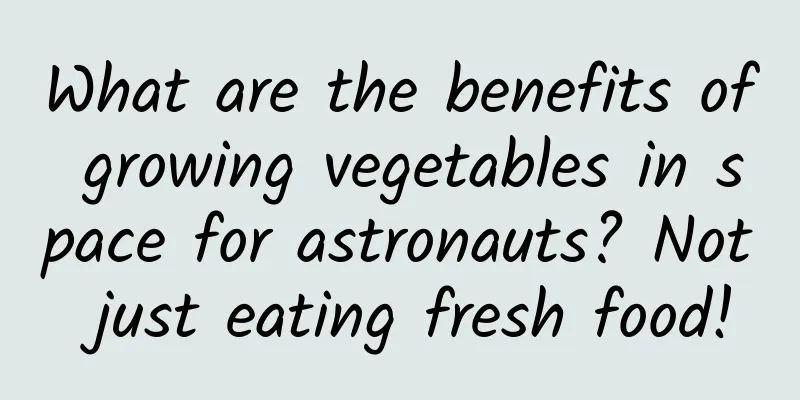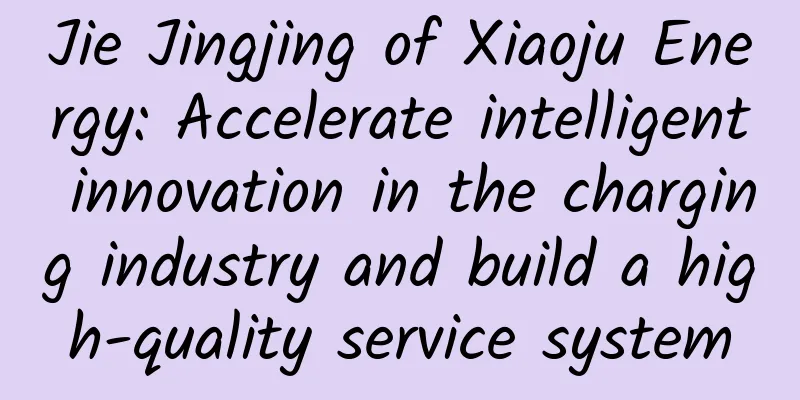What are the benefits of growing vegetables in space for astronauts? Not just eating fresh food!

|
How to use plants to ensure the food, oxygen and pure water needed for human survival in the extraterrestrial environment is the most concerned issue in space life science. With the completion of the construction of the Chinese space station, more plant growth experiments will be carried out in the Chinese space station in the future. So, why do we need to grow plants in space? Science fiction fantasy from more than a hundred years ago has become part of astronauts' menu today The growth of plants in outer space is of great interest to the scientific community. As early as 1869, the short story "The Brick Moon" discussed how to plant trees on the lunar space station. The author envisioned building an artificial satellite with 13 cabins made of bricks. Among the supplies brought into space were some small poultry and grains. After going into space, they evolved according to the theory of evolution and developed a sound ecosystem in just a few months. Today, this joke seems a bit too much, but we can assert that cultivating plants in space and being self-sufficient is by no means a new idea. Since the beginning of modern spaceflight, plants have often been taken to low-Earth orbit to grow in a weightless but pressurized controlled environment. In manned spaceflight environments, they can serve as food, metabolize carbon dioxide in the air, produce oxygen, and help control the humidity in the cabin. Planting plants in space can also improve the mood of astronauts. Therefore, space plants will definitely be one of the important contents of manned space activities, especially future manned deep space exploration. Astronauts take care of the vegetable production system equipment in the space station The first challenge of growing plants in space is how to make them grow without gravity. This not only involves how weightlessness affects the root system, but also tests how people provide appropriate lighting - if the sun is directly exposed to the plant, it will either die or cause unpredictable mutations. Especially the root system. We all know that the root system is used to provide nutrients for plants, and its relationship with the earth's biochemical cycle and the interaction with microorganisms in the soil is very complex. But space flight has proved that plant roots can continue to work in subgravity and microgravity. An orange redbud plant grown on the International Space Station in January 2016 After years of hard work, growing vegetables for our own consumption in space has entered the experimental stage. In 2017, the fifth batch of turnips was grown in a plant growth device on the International Space Station, part of which was eaten by astronauts and the rest was preserved for research. We have reason to believe that space vegetable gardens and space farms will not be a distant thing. Astronaut Jessica Meir enjoys freshly harvested green mustard on the International Space Station The earliest plants in space The first biological organisms to go into space were launched by the United States on July 9, 1946. The vehicle used at the time was a V-2 rocket collected from Germany, which was launched to an altitude of 134 kilometers. The specific items were "specially developed seeds", but the samples were not recovered. On July 30, 1946, the United States successfully launched and recovered a batch of corn seeds. Later, rye and cotton seeds were also launched. These early suborbital biological experiments were conducted by Harvard University and the Naval Research Laboratory, mainly studying the effects of cosmic radiation on living tissue. V-2 rocket On September 22, 1966, the Soviet Union's Cosmos 110 satellite carried two dogs and a batch of moisturized seeds into space. After returning to the ground, several of these seeds sprouted and harvested lettuce, cabbage, and some beans that were higher in yield than the control samples on Earth. In 1971, Apollo 14 carried 500 tree species on a lunar flight, including loblolly pine, sycamore, maple, maple, redwood, and Douglas fir. After returning to Earth, these tree species sprouted, but no changes were detected. In 1982, astronauts on the Soviet Salyut 7 space station conducted an experiment in which Alfonso Merkes, a scientist from the then Lithuanian Soviet Socialist Republic, and others used the Fiton-3 experimental micro-greenhouse device to grow some Arabidopsis, becoming the first plants to flower and produce seeds in space. At the same time, the U.S. Skylab studied the effects of microgravity and light on rice. In 1997, the SVET-2 space greenhouse successfully achieved seed plant growth on the Mir space station. The aforementioned Cosmos 110 belongs to the Soviet/Russian BION series of biological satellites. It is based on the Zenit recoverable satellite and focuses mainly on the impact of radiation on humans. The plan is to launch a total of 11 satellites by 2013. These include Cosmos 110, 605, 690, 782, etc. BION 5 satellite In 1971, the USSR and the USSR signed the "Agreement on Science and Applications between the USSR and the USSR". The USSR and the USSR conducted their first joint research on the Cosmos-782 mission in 1975, and then participated in eight more flight tests. The BION11 mission in December 1996 was the last time the US participated. During these missions, the Americans conducted more than 100 experiments in total, and the length of the flight tests ranged from 5 days for BION6 (Cosmos-1514) to 22 days for BION1 and Cosmos-110. Some plant experiments have also been conducted on space shuttles. For example, in 1983, Allen H. Brown observed the movements of sunflower seedlings while on the Columbia space shuttle. They observed that despite the absence of gravity, the seedlings still experienced rotational growth, indicating that these behaviors are instinctive for the plant. In December 2018, the German Aerospace Center launched the EuCROPIS satellite into low Earth orbit. The mission carried two greenhouses intended to grow tomatoes (for six months in each greenhouse) in simulated lunar and Martian gravity, using the byproducts of the human presence in space as a source of nutrition. Plant experiments on the space station From the Salyut Space Station to the Mir Space Station, and then to the International Space Station, plant experiments have always been one of the key contents. The 1982 experiment on the Salyut 7 space station mentioned above was not successful. Arabidopsis thaliana grew from seeds to maturity, and then to flowering and fruiting, which was considered limited success, but the plant growth was very slow and overall poor. These plants grew in space for 69 days. After returning to the laboratory on Earth, about 200 seeds stopped developing. In addition, compared with the ground control group grown in the same plant growth device, the plants grew much less vigorously and healthily, and many of the seeds produced were empty. Salyut 7 space station The Soviet Union deployed its own Svetoblock-M device on the Mir space station and conducted some wheat growth experiments, but it was also unsuccessful. This super dwarf wheat grew for 167 days, but was only 13 cm tall and had only one tiller. Due to poor light conditions, no seeds were collected (nor in the control experiment on Earth). Some of the wheat matured under slightly higher light after returning to the Earth laboratory and produced 28 seeds. It was not until 1990 that Soviet astronauts conducted a 54-day long-term plant experiment on white-topped carrots and Chinese cabbages on the Mir space station using the SVET equipment developed by Bulgaria, which really achieved initial success. Since then, a large number of plant experiments have been carried out on the Mir space station, and many results have been achieved. After the International Space Station was put into use, it provided better conditions for plant experiments. The experimental equipment of this era needs to be developed according to the size and interface requirements of standard experimental cabinets. Not only the United States and Russia, but also Europe and Canada have implemented their own plant experiments and achieved gratifying results. The process of wheat from germination to heading in the space station Future Space Plants According to scientists, building a biological life support system based on the recycling of chemical elements in the Earth's biosphere is a fundamental but very complex scientific task of human civilization and a prerequisite for future long-term manned space missions. In theory, a system including higher plants and animals can ensure 90% to 95% of the resources needed for astronauts' lives. Plants will produce food and oxygen for astronauts, while removing carbon dioxide and excess humidity from the enclosed cabin environment. By analogy with natural ecosystems, the functions of biological life support systems include organisms that provide primary nutrition. The first level is the energy "gate" of the system, which is to convert external energy into biological nutrition. This is the basis for the existence of the system. And this level is still produced by plant photosynthesis. Russian cosmonauts take care of the Lada system on the International Space Station The next trophic level is occupied by heterotrophs, including humans and animals. They ingest plants and produce organic matter. The last link in the trophic chain is made up of different microorganisms (fungi, bacteria, etc.), which complete the decomposition of organic matter and convert it into mineral elements that plants can use. Plants are an essential part of the biological life support systems that will power future space stations and spacecraft traveling to other planets. By maximizing the yield of edible plant products, researchers can supplement the food currently shipped from Earth with fresh food grown in space. Vision of the future farm on Mars Plants can also regenerate the atmosphere on board by emitting oxygen through photosynthesis and absorbing carbon dioxide produced by astronauts' breathing. At the same time, considering the complexity of living and working in a closed space for a long time, the psychological impact of caring for a garden far away from the earth is benign, which will contribute to the success of the space mission. Although plants are so important, they do not have a mature nervous system and are therefore less able to adapt to extreme space conditions than humans and animals. They react to adverse environmental conditions by developing "stress," stopping growth, or even dying. Early signs of stress are invisible to the naked eye. By the time people discover them, the plants may have been too damaged to be saved. This is the main task of today's space plant experiments. By establishing automatic monitoring methods to monitor the photosynthesis and transpiration of plants, we can provide plants with a "stress-free growth environment" to ensure that they grow normally, bloom and bear fruit, and become food for humans. |
>>: There are so many "rules" for choosing seats in the cinema? Where is the best place to sit?
Recommend
Free name scoring test is the most accurate, free name selection based on birth date
About Name Test Scoring The traditional Chinese c...
A Star Trek-like legend! Samples from the asteroid Bennu were successfully returned, or could they reveal the origin of life?
Digging "soil" from outer space to draw...
Which one has better car-making genes, Gree or LeTV?
Among Chinese entrepreneurs, apart from Dong Ming...
Wang Nan will help you build your account for 21 days + 21 days of running course video
Wang Nan’s 21 Days to Help You Create an Account ...
"Warcraft" is a huge hit! The box office has reached nearly 600 million in two days. Why is it so popular?
"World of Warcraft" became popular afte...
I’d like to share with you a way to make money that doesn’t require any traffic and can be done mindlessly. You can earn over 10,000 yuan a month. I suggest you make money quietly!
Today I want to share with you a way to make mone...
Interesting Talk | Why haven’t humans formed a large number of fossils? Is it because human “skeletons” do not have the conditions to form?
I believe everyone has seen photos of fossils. Sc...
Why these plants? They are delicious and can fight zombies
Author: Riboapartment (Kunming Institute of Botan...
The most practical Android architecture design principles
Before we begin, I assume you have read my previo...
Storm Technology is losing its luster and its future is uncertain: the effect of patch-like layout is unknown
Layout, upgrade, expansion... Baofeng Technology ...
Latest! Monkeypox will be included in Class B infectious diseases. Learn more about prevention in one picture
According to the website of the National Health C...
Queqiao-2: How does the “postman” on the Moon “chat” with the Earth?
Did you know that the Earth and the far side of t...
"The rumbling of the chariots and the neighing of the horses" is the majestic first chariot of the Han Dynasty.
The Ziyang Bronze Chariot is an outstanding repre...
Tu Shou'e: A pioneer in the development of Chinese rocket technology | The childhood of the founder of the "two bombs and one satellite"
Tu Shou'e, an expert in rocket design, is one...









